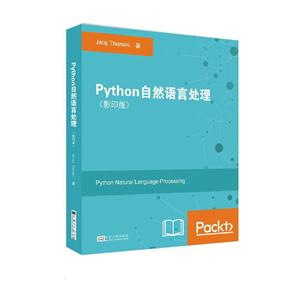扫一扫
关注中图网
官方微博
本类五星书更多>
-
>
全国计算机等级考试最新真考题库模拟考场及详解·二级MSOffice高级应用
-
>
决战行测5000题(言语理解与表达)
-
>
软件性能测试.分析与调优实践之路
-
>
第一行代码Android
-
>
C Primer Plus 第6版 中文版
-
>
深度学习
-
>
MATLAB计算机视觉与深度学习实战-赠在线交流卡和本书源码
Python自然语言处理 版权信息
- ISBN:9787564178659
- 条形码:9787564178659 ; 978-7-5641-7865-9
- 装帧:一般轻型纸
- 册数:暂无
- 重量:暂无
- 所属分类:>
Python自然语言处理 内容简介
解释了为什么Python是构建基于NLP的专家系统的佳选之一。通过本书你将知道如何为自然语言处理应用程序选择数据集,并找到正确的NLP技术来处理数据集中的句子并理解它们的结构。你还将学习如何标记句子的不同部分以及分析它们的方法。你将探索文本的语义和句法分析,还将了解如何处理人类语言中的各种歧义,并在各种场景中执行文本分析。
Python自然语言处理 目录
Preface
Chapter 1:Introduction
Understanding natural language processing
Understanding basic applications
Understanding advanced applications
Advantages of togetherness—N LP and Python
Environment setup for NLTK
Tips for readers
Summary
Chapter 2:Practical Understanding of a Corpus and Datase
What is a corpus
Why do we need a corpus
UnderStanding corpus analysis
Exercise
Understanding types of data attributes
Categorical or qualitative data attributes
Numeric or quantitative data attributes
Exploring different file formats for corpora
Resources for accessing free corpora
Preparing a dataset for NLP applications
Selecting data
Preprocessing the dataset
Formatting
Cleaning
Sampling
Transforming data
Web scraping
Summary
Chapter 3:Understanding the Structure of a Sentences
Understanding components of NLP
Natural language understanding
Natural language generation
Differences between NLU and NLG
Branches nf NLP
Defining context-free grammar
Exercise
Morphological analysis
What is morphology
What are morphemes
What is a stem
What is morphological analysis
What iS a word
Classification of morphemes
Free morphemes
Bound morphemes
Derivational morphemes
Inflectional morphemes
What is the difference between a stem and a root
Exercise
Lexical analysis
Whal is a token
What are part of speech tags
Process of deriving tokens
Difference between stemming and lemmatization
Applications
Syntactic analysis
What is syntactic analysis
Semantic analysis
What is semantic analysis
Lexical semantics
Hyponymy and hyponyms
Homonymy
Polysemy
What is the difference between polysemy and homonymy
Application of semantic analysis
Handling ambiguity
Lexical ambiguity
Syntactic ambiguity
Approach to handle syntactic ambiguity
Semantic ambiguity
Pragmatic ambiguity
Discourse integration
Applications
Pragmatic analysis
Summary
Chapter 4: PreproceSSing
Chapter 5: Feature Engineering and NLP Alclorithms
Chapter 6:Advanced Feature Engineering and NLP Algorithms
Chapter 7: Rule-Based System for NLP
Chapter 8: Machine Learning for NLP Problems
Chapter 9: Deep Learnincl for NLU and NLG Problems
Chapter 10: Advanced Tools
Chapter 11 : How to Improve Your NLP Skills
Chapter 12: Installation Guide
Index
展开全部
书友推荐
本类畅销
-
区块链开发从入门到精通 以太坊+超级账本
¥55.9¥79.8 -
C和指针
¥69.3¥99 -
超简单用PYTHON让Excel飞起来
¥54.4¥69.8 -
超简单:用Python让Excel飞起来(实战150例)
¥55.9¥79.8 -
新编C语言习题与解析
¥48.3¥69 -
深入浅出Pandas:利用Python进行数据处理与分析
¥84.2¥99
















